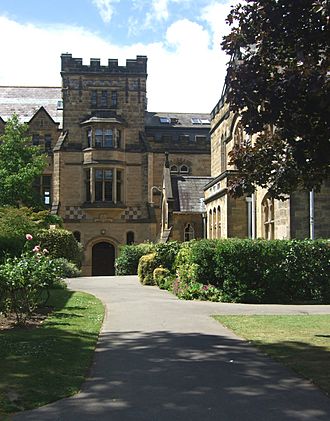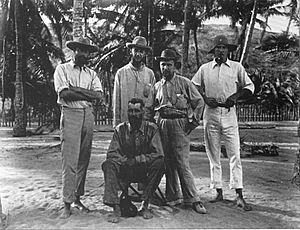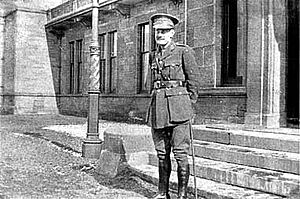W. H. R. Rivers facts for kids
Quick facts for kids
W. H. R. Rivers
FRS FRAI
|
|
|---|---|
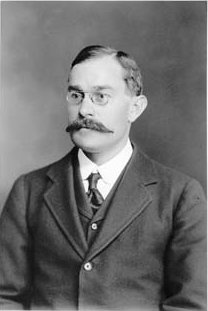
Portrait by Henry Maull
|
|
| Born |
William Halse Rivers Rivers
12 March 1864 Chatham, Kent, England
|
| Died | 4 June 1922 (aged 58) Cambridge, England
|
| Alma mater | St Bartholomew's Hospital Medical College |
| Known for |
|
| Awards |
|
| Scientific career | |
| Fields | |
| Institutions | |
| Doctoral students |
|
| Influenced | |
| Signature | |
William Halse Rivers Rivers (born March 12, 1864 – died June 4, 1922) was an English expert in many fields. He studied the human mind (psychology), the human body (neurology), different cultures (anthropology and ethnology), and mental health (psychiatry). He is most famous for helping soldiers who suffered from "shell shock" during the First World War. His most well-known patient was the poet Siegfried Sassoon, who became a close friend.
In the early 1900s, Rivers created new ways to study psychology. He was the first to use a "double-blind" method in his research. This method helps make sure that experiments are fair and unbiased. He also led psychology studies at two colleges and was part of an important expedition to the Torres Strait Islands in 1898. His work there helped us understand how different cultures organize their families.
Contents
About William Rivers
His Family and Early Life
William Halse Rivers Rivers was born in 1864 in Chatham, Kent, England. His parents were Elizabeth Hunt and Henry Frederick Rivers. The Rivers family had a history of serving in the Royal Navy and the Church of England.
William was the oldest of four children. He had a brother named Charles and two sisters, Ethel and Katharine. William was known as "Willie" when he was young. He had a stammer, which is a speech difficulty, that he never fully overcame.
William was a very smart child. He went to Tonbridge School and was excellent in his studies. He was even placed in a class a year above his age group. When he was 16, he got typhoid fever and had to miss his last year of school. This meant he couldn't go to Cambridge University right away, as his family couldn't afford it without a scholarship.
Despite this setback, Rivers decided to study medicine. He went to the University of London and St Bartholomew's Hospital in London. He became a doctor at the young age of 22.
Traveling as a Ship's Doctor
After becoming a doctor, Rivers wanted to join the army, but his health wasn't good enough because of his earlier typhoid fever. He often got tired easily.
Instead, Rivers became a ship's surgeon. This allowed him to travel a lot, visiting places like Japan and North America in 1887. These trips helped his health and he enjoyed his time at sea. He even spent a month talking with the famous writer George Bernard Shaw, which he called "the greatest treat of my life."
Starting a Career in Psychology
Rivers returned to England and continued his medical studies. He became a Fellow of the Royal College of Physicians. He worked at hospitals and became very interested in the brain and the mind. He studied conditions like delirium, hysteria, and neurasthenia.
In 1891, Rivers met Henry Head at the National Hospital for the Paralysed and Epileptic. They became lifelong friends and worked together on many projects. Rivers also helped with research at University College London, exploring how the brain uses electrical currents.
To learn more about psychology, Rivers traveled to Jena, Germany, in 1892. He learned German and attended lectures on psychology and philosophy. He decided he wanted to focus on mental health when he returned to England.
Back in England, he worked at Bethlem Royal Hospital and taught about mental diseases at Guy's Hospital. He also started lecturing on experimental psychology at University College, London.
In 1893, Rivers was invited to teach at University of Cambridge. He became a Fellow at St John's College in 1902. He was so dedicated that he became the director of the first two psychology laboratories in Britain at the same time.
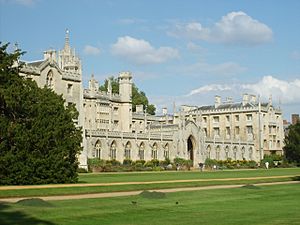
Rivers and other Cambridge psychologists were very interested in how our senses work, like sight and hearing. Rivers became well-known in these areas. He also studied how things like tea, coffee, and alcohol affected people's physical and mental abilities. He was the first to use a "double-blind" procedure in these experiments, where neither he nor the subjects knew if they were getting the real substance or a control. This made his research very fair and accurate.
In 1897, Cambridge University recognized his achievements with an honorary degree. In 1904, he helped start and edit the British Journal of Psychology, an important scientific journal.
Torres Straits Expedition
Rivers loved new experiences. In 1898, Alfred Cort Haddon invited him to join an expedition to the Torres Strait Islands. Rivers agreed, especially since two of his best former students, C. S. Myers and William McDougall, were also going.
The expedition faced challenges, including bad weather and Rivers getting very sick. But the islanders were kind and helped him recover. This made Rivers care deeply about the people of Melanesia for the rest of his life.
Rivers' first job was to study the islanders' color vision. He found that color-blindness was rare among them, but their color vision was different from Europeans. For example, they didn't have a word for blue and might use the same name for the blue sea and deep black. He also showed that their excellent vision was due to their ability to notice small details in their familiar surroundings, not super-human eyesight.
During this trip, Rivers started collecting family histories and creating family trees. He realized that the islanders' family names were not just about biology, like in Europe. They showed specific duties, rights, and rules for how people should act towards each other. This way of studying families, called the "genealogical method," changed how people studied different cultures.
The Torres Straits expedition was a big step forward for anthropology in Britain. It moved the study of cultures from just reading books to doing real fieldwork. This set a new standard for future anthropologists.
Studying the Todas People
After the Torres Straits expedition, Rivers focused more on anthropology. He wanted to study a small, isolated group of people where he could collect detailed family information. He found the Todas people in the Nilgiri Hills of Southern India.
Rivers worked with the Todas for less than six months in 1901–02. He used interpreters to communicate. Even with this short time and language barrier, he gathered an amazing amount of information about their rituals and social lives. His book, The Todas (1906), is still considered a very important book about Indian cultures.
Experimenting with Nerve Recovery
After returning from the Torres Strait, Rivers joined his friend Henry Head in a unique experiment. Head, a surgeon, volunteered to have two nerves in his arm cut and then sewn back together. Rivers then carefully observed and recorded how the nerves healed over five years.
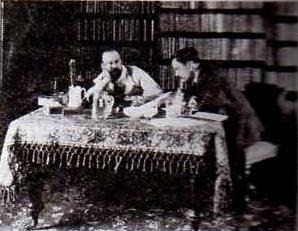
They found that the arm's feeling returned in two stages. First, certain spots became sensitive to heat, cold, and pressure, but these feelings were often unpleasant or painful. They called this the "protopathic" stage. Later, Head could tell the difference between different temperatures and sensations more clearly. They called this the "epicritic" stage. This experiment helped them understand how the nervous system recovers and how different parts of our senses work.
Psychology Before the War
In 1904, Rivers helped create the British Journal of Psychology. From 1908 until World War I, he mostly studied different cultures and societies. He still believed that his training in psychology was important for his work in anthropology.
Between 1907 and 1908, Rivers traveled to the Solomon Islands and other parts of Melanesia and Polynesia. His two-volume book, History of Melanesian Society (1914), explored how culture developed in the South Pacific.
World War I and Shell Shock
When Rivers returned to England in 1915, he wanted to help with the war effort. At 51, he became a civilian doctor at the Maghull Military Hospital. He was appointed as a psychiatrist, working with soldiers who had "shell shock."
"Shell shock" was a term for many symptoms soldiers experienced, like temporary blindness, memory loss, paralysis, and uncontrollable crying. Rivers and other doctors at Maghull used methods like dream interpretation and hypnosis to treat these "war neuroses."
Rivers later became a captain in the Royal Army Medical Corps and was transferred to Craiglockhart War Hospital in Scotland. There, he treated officers with shell shock and developed his own ideas about how these conditions started and how to treat them. He believed that soldiers' strong desire for self-preservation was a key factor.
Rivers used a "talking cure," which was based on the idea that bringing difficult memories into the open could help reduce their power. He talked with officers, helping them understand their illness and find ways to cope. He taught them that their illness was not strange or permanent.
Rivers' approach was very kind and new for his time. He encouraged soldiers to express their feelings, even though society often told men to be tough. His methods made him well-known and respected by his patients, including Siegfried Sassoon and Robert Graves.
Rivers faced a difficult choice: healing his patients so they could return to the war, where they might die. He felt this guilt, which is shown in his writings and in books about him. Sassoon called him his "father confessor."
Rivers and Sassoon
Sassoon came to Rivers in 1917 after protesting the war. Rivers treated him with understanding and gave him freedom until Sassoon chose to return to France. Rivers was known for his caring and effective treatments. Sassoon described Rivers as a calm and wise presence who helped him feel better.
Rivers' Book: Instinct and the Unconscious
In 1920, Rivers published his main theory on mental health issues, including war neuroses, in his book Instinct and the Unconscious. He believed that our unconscious mind holds instincts and painful memories that we try to keep hidden.
Rivers thought that mental health problems happen when these hidden instincts and emotions break free from the unconscious. For example, in war, the "self-preservation" instincts (like fear or the urge to flee) are constantly active. When these instincts become too strong, they can "escape" into our conscious mind, causing conflict and leading to conditions like night terrors or hysteria.
Rivers' ideas were new for his time and combined his knowledge of neurology and psychology. While his specific theories might not be widely used today, his work, along with other psychiatrists treating war neuroses, greatly changed how Britain viewed and treated mental illness.
After the War
After the war, Rivers seemed to change. He became more outgoing and confident. He enjoyed public speaking, joined clubs, and read widely in philosophy and literature. He said he had "finished my serious work and I shall just let myself go."
He returned to St John's College, Cambridge and was given a new role as "Praelector of Natural Science Studies." He used this role to connect with students, holding gatherings and lectures. He also formed a group called The Socratics and invited influential friends like H. G. Wells and Bertrand Russell. Sassoon remained a close friend and mentor.
Rivers received many honors, including honorary degrees from several universities. He also became president of important groups like The Folklore Society and the Royal Anthropological Institute.
Rivers died suddenly in June 1922, at the age of 58. He had agreed to run for parliament as a Labour candidate because he felt he could help the country. He was selfless to the end, signing important documents even as he was dying. His funeral was held at St John's, and his ashes were buried in Cambridge. Sassoon was very sad about his death and wrote two poems about him.
What Others Thought of Rivers
Many people admired and loved Rivers. The poet Robert Graves wrote about the peace he felt in Rivers' rooms. Frederic Bartlett, a colleague, wrote that Rivers was both understanding and strict, always aiming to find the truth. He said Rivers had a special way of understanding others' lives and helping them realize their potential.
Sassoon described Rivers as a "wise man" who brought peace and helped him feel strong again.
Rivers' legacy continues today. The Rivers Centre helps people with posttraumatic stress disorder using similar kind methods. There is also a Rivers Memorial Medal, given each year to an anthropologist who has made a big impact in their field.
Rivers in Books and Movies
Rivers' life and his time with Sassoon were made into a series of three books by Pat Barker, called the Regeneration Trilogy. These books include Regeneration (1991), The Eye in the Door (1993), and The Ghost Road (1995). The Ghost Road won the Booker Prize.
The first book, Regeneration, shows Rivers as a doctor who struggles with the idea of healing soldiers just to send them back to war. It also compares his kind methods to other doctors who used harsh treatments.
The other books explore more about Rivers' life, including his relationships and his travels to Melanesia. In 1997, Regeneration was made into a movie, with Jonathan Pryce playing Rivers.
Images for kids
Error: no page names specified (help).
- Ernest Jones
- Gustave Le Bon
- J. A. Hadfield
- Wilfred Bion


